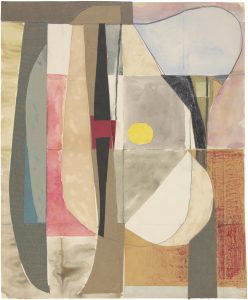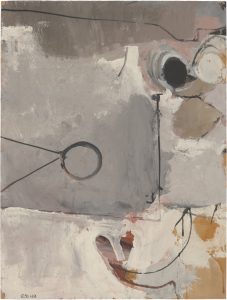Art Talk Podcast: Richard Diebenkorn at Weisman Museum at Pepperdine
By Hunter Drohojowska-Philp

One of the premier painters to emerge in post-war California, Richard Diebenkorn is well known for his talent and his teaching at UCLA. So well known that discovering a cache of previously unexhibited paintings is sufficient reason for a focused exhibition like the one at Pepperdine’s Weisman Museum of Art. Richard Diebenkorn: Beginnings, 1942-1955 is on view through March 31.
Southern California audiences are likely to be most familiar with his abstract landscapes based on the Santa Monica neighborhood of Ocean Park, considered the pinnacle of an illustrious career.
This exhibition, organized by Scott Shields for the Crocker Art Museum with the Diebenkorn Foundation, is the first to explore the early years while he was still in college or the military in the 1940s and ‘50s. The paintings and works on paper are from the Diebenkorn Foundation though not previously shown.
The show is a brief but potent demonstration of the artist’s ability to assimilate concepts of early abstract art and transform them for his own use.
Diebenkorn was raised in the Bay Area, where he enrolled at Stanford in 1940 and he met his future wife and influential partner, Phyllis. After the attack on Pearl Harbor, he enrolled in the Marines.
As a reservist, he was transferred to U.C. Berkeley, which had an art department with a more modern orientation. As part of an officers training program, which he never completed, he was sent to Camp Quantico, Virginia. Visiting the museums of nearby Washington, D.C., he took in ideas about Cubism and Surrealism and the history of modern art on a deeper level.
Military service took him to other parts of the south and to Hawaii.
After the war, in 1946, he used the G.I. bill to continue his studies at the California School of Fine Arts, (now the San Francisco Art Institute), one of the most advanced progressive programs in the country dominated by the abstract expressionist Clyfford Still. Another teacher, David Park, became Diebenkorn’s friend and mentor.
Within a year, Diebenkorn’s talent was so obvious, he was awarded a financial stipend to study in New York and promise of a job teaching at CSFA when he returned in 1947. In 1950, he moved to Albuquerque, New Mexico to pursue a masters degree, then to Urbana, Illinois to teach before getting back to Berkeley in 1953.

Why go over his peripatetic past? Because in little more than a decade, Diebenkorn had lived in the Bay Area, the South, the East and the West. Each location had inspired abstract painting based in the color and shape of landscape.
The show includes a small selection of his early still life and figure studies, sketches from his time in the military during World War II. Prior to 1946, even his landscape-influenced art was haunted by the hovering ghosts of Cubism and Surrealism.
The artist was trying to find himself. By 1947, his individualistic use of line, the balance between shape and atmosphere, the basis of much that characterizes his art for decades to come, is established. It is like someone learning how to pronounce a foreign language, gaining the deftness and ease that comes with repetition. What is illuminating in this show is how many of the pictorial mannerisms — the serpentine line delineating an expanse of space — were developed when he was in his twenties.
Diebenkorn painted in both representational and abstract ways at different points in his career but always with an expressive flourish to his brush strokes.
This gathering acts as a preamble and tells the story of an artist exploring representational art, then abstract expressionist notions. In the early 1950s, however, Diebenkorn, with David Park and other Bay Area painters rejected the dominance of Abstract Expressionism and established their own movement of loosely rendered pictures of people and places known as Bay Area Figuration.
This show concludes with a painting of a horse and rider. Diebenkorn himself said that he did not hold by distinctions between painting the figure and painting in ways that were non-representational. This exhibition establishes his early claim to that view.
Diebenkorn remained in the Bay Area, teaching at California College of Arts and Crafts, until he was hired by UCLA in 1966. At first, he rented a studio from artist Sam Francis but remained in the Ocean Park area and continued paintings in that series until 1988. Connections from work as early as 1948 and 1968 spring to mind throughout this show.
Diebenkorn is seen today as an established master. This fascinating exhibition offers an unprecedented opportunity to see the artist as a young man and set out on his journey with him. More information at pepperdine.edu.